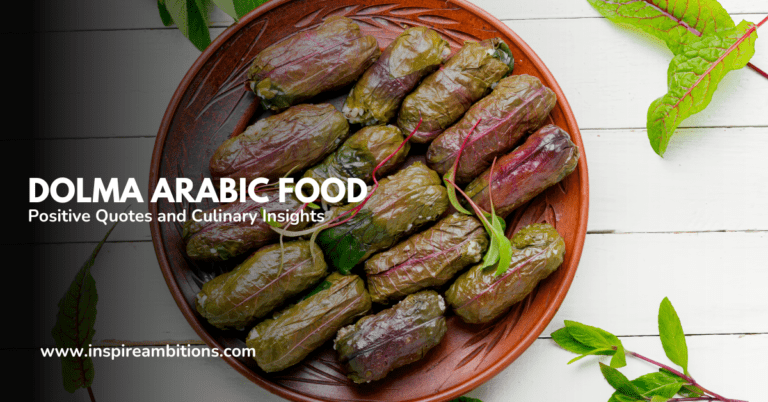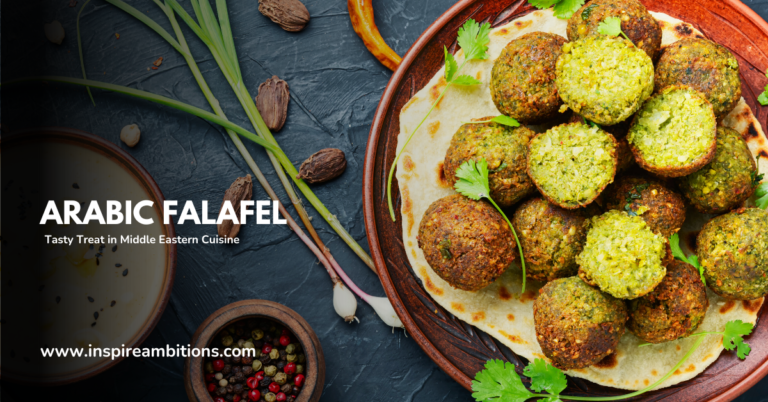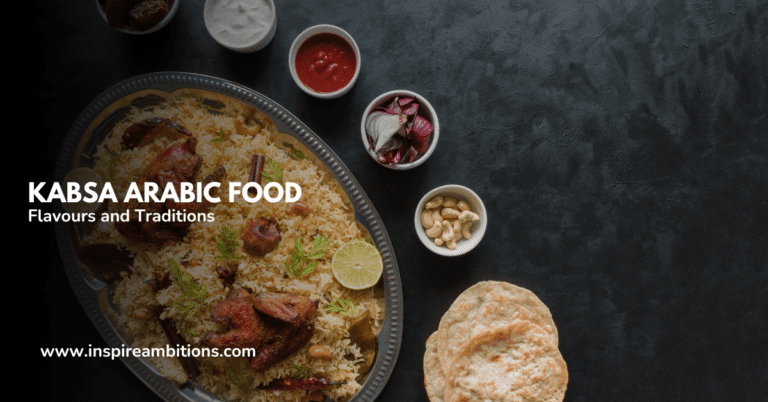আরবি খাবার - খাঁটি স্বাদের মাধ্যমে একটি রন্ধনসম্পর্কীয় যাত্রা
Arabic cuisine is as diverse and rich as the regions it represents, ranging from the Maghreb to the Fertile Crescent and the Arabian Peninsula.
Throughout history, trade routes have played a significant role in shaping the culinary traditions of the Arab world. As you explore this ancient cuisine, you’ll discover a range of flavours, spices, and techniques that have been utilized for centuries.
One of the most well-known aspects of Arabic food is its use of spices, with baharat being a popular spice mix incorporating ingredients such as nutmeg, cardamom, coriander, paprika, black pepper, cinnamon, cumin, and cloves.
Additionally, distinctive dishes, such as manakeesh (the pizza of the Arabic world), fattoush (a bread salad traditional to Levantine cuisine), and hummus, showcase the unique elements of this cultural gastronomic experience.
By indulging in these culinary delights, you’ll gain an appreciation for the Arab world’s diverse heritage, as well as the delectable tastes and textures that have evolved. So, as you embark on this culinary journey, prepare your taste buds for a truly exceptional experience.
History of Arabic Food
Arabic cuisine can be traced back to the various regional cuisines of the Arab world, spanning from the Maghreb to the Fertile Crescent and the Arabian Peninsula.
These regional cuisines have been shaped by the culture of trading in ingredients, spices, herbs, and commodities throughout centuries.
The history of Arab food has its roots in the ancient civilisations of the Middle East. The Sumerians, Babylonians, Phoenicians or Canaanites, Hittites, Arameans, Assyrians, Egyptians, and Nabateans all contributed to the formation of the Arab kitchen.
As you explore this rich culinary heritage, you’ll find a blend of traditions that have evolved, incorporating the culinary practices of many different cultures.
In the early days of Arab cooking, people relied on simple, fresh ingredients that were readily available in their region.
Gradually, as trade networks expanded, the range of ingredients and flavours grew, giving rise to the diverse and sophisticated recipes that are now associated with Arabic cuisine.
Throughout history, various Arab dynasties placed great importance on the culinary arts, with cuisines often representing the power and wealth of empires.
One notable example was the Abbasid Caliphate, which adopted a liberal approach to culinary matters and eventually produced culinary masterpieces during its golden age.
While Middle Eastern and Arab cuisines share some common ingredients – olives, olive oil, pitas, honey, sesame seeds, dates, sumac, chickpeas, mint, rice, and parsley – each region has its distinct flavours and techniques.
Popular dishes such as kebabs, dolmas, falafel, baklava, yoghurt, doner kebab, shawarma, and mulukhiyah highlight the variety and depth of Arabic cooking.
তোমার মত journey through the history of Arabic food, you’ll discover a fascinating culinary heritage that has stood the test of time, encompassing a multitude of cooking traditions, flavours, and innovations.
Key Ingredients in Arabic Cuisine
Arabic cuisine is diverse and rich in flavours, spanning from the Maghreb to the Fertile Crescent and the Arabian Peninsula. As one of the oldest cuisines, it is known for its unique blend of spices and staple ingredients. We’ll now explore some key ingredients you’ll find in Arabic cooking.
ছোলা play a vital role in Middle Eastern dishes, most notably in hummus. This versatile legume is combined with tahini, garlic, lemon juice, and olive oil to create the beloved dip and spread.
Wheat is another essential ingredient, often found in forms such as flour, pita bread, couscous, and bulgur. Wheat is used in various dishes, from salads to main courses, providing both nutrition and texture.
In Arabic cuisine, a range of spices and seasonings are used to create complex and robust flavours. Here are some commonly employed spices:
- Cumin (Kammun): Known for its earthy and slightly bitter taste, cumin is a staple in many dishes.
- Ginger (Zanjabil): This aromatic spice brings a warm, slightly sweet heat to various recipes.
- Nutmeg (Jawazat al-Tib): Nutmeg provides a hint of sweetness and warmth in dishes like Kibbeh, a mix of bulgur, onion, and minced meat.
- Paprika (Fulful Ahmar): Often used for its mild sweetness and rich colour, paprika can be found in many recipes.
- Pepper (Fulful): A fundamental ingredient in countless dishes, black or white pepper is a must-have in Arabic cooking.
- Saffron (Za’faran): Prized for its distinct flavour and stunning hue, saffron is used in both savoury and sweet dishes.
When exploring Arabic cuisine, you’ll notice the generous use of ফল এবং শাকসবজি. Tomatoes, onions, and bell peppers are common components of many dishes, while dates, figs, and apricots add natural sweetness to various recipes.
তাছাড়া, olive oil is often used in cooking, dressings, and dips, imparting a subtle fruity taste and supplying essential nutrients.
Armed with this knowledge of key ingredients, you’re well on your way to appreciating the intricacies of Arabic cuisine.
জনপ্রিয় আরবি খাবার
হুমাস
Hummus, a creamy dip made from chickpeas, tahini, olive oil, lemon juice, and garlic, is a staple in many Middle Eastern cuisines. You can enjoy this versatile dish as a dip with pita bread or fresh vegetables or as a spread in sandwiches and wraps.
The basic recipe can be easily adapted with additional ingredients like roasted red peppers or sun-dried tomatoes for a unique twist on the traditional flavour.
ফালাফেল
Falafel, deep-fried balls or patties made from ground chickpeas, fava beans, or a combination of both, is a popular and nutritious dish.
They are commonly served in pita bread with toppings such as lettuce, tomatoes, pickles, and tahini sauce. Whether eaten alone as a snack or wrapped in a sandwich, falafel offers a satisfying, protein-packed meal.
শওয়ারমা
Shawarma, a delicious and flavourful Middle Eastern street food, consists of thinly sliced marinated meat, usually lamb, chicken, or beef, slow-roasted on a vertical spit.
Served wrapped in flatbread or as part of a platter, this dish is often accompanied by vibrant condiments, such as garlic sauce, pickles, and shredded vegetables. The flavourful combination of tender meat, tangy sauce, and fresh toppings creates a satisfying culinary experience.
তাব্বুলেহ
Tabbouleh, a refreshing Levantine salad, features finely chopped fresh parsley, mint, tomatoes, and onions, combined with bulgur wheat or even couscous, dressed with lemon juice and olive oil.
This healthy, light dish is perfect for hot summer days and makes for a delightful side to grilled meats or as part of a mezze spread. The zesty lemon dressing and aromatic herbs make this salad a crowd-pleaser.
বাকলাভা
Baklava, a rich and delicious pastry dessert, is made of layers of thin, crisp filo dough, finely chopped nuts, such as pistachios, walnuts, or hazelnuts, and a sweet, fragrant syrup made with sugar, honey, and aromatic spices like cinnamon and cardamom.
Baked to golden perfection and finished with a drizzle of honey syrup, this sweet treat is a fitting finale to any Arabic meal.
Arabic Food Culture and Traditions
Arabic cuisine is a diverse and rich culinary tradition that spans many centuries and covers a vast geographical area, from the Maghreb in the west to the Fertile Crescent in the east, and down to the Arabian Peninsula.
You’ll discover that fundamentally, this cuisine reflects a culture of trading in ingredients, spices, and preparation methods which have evolved.
Like many traditional cuisines, the food you’ll find throughout the Arab world is deeply rooted in the region’s history, climate, and local produce.
A few staple ingredients you’ll encounter when exploring Arabic foods are grains like couscous and rice, legumes such as chickpeas, vegetables, and a wide variety of herbs and spices.
Some notable spices that form the backbone of many আরবি খাবার include baharat, a blend of spices like nutmeg, cardamom, and coriander, and ras el hanout, a popular North African spice mix.
Meals in the Arab world are often communal and centred around family gatherings. One important aspect is the mezze, an array of small dishes that are typically shared at the beginning of a meal.
You might be familiar with popular mezze items like hummus, tabbouleh, and falafel. Additionally, meats such as chicken, lamb, and beef are common in many Arabic dishes but are often cooked and spiced in an array of different ways, reflecting the region’s diverse culinary influences.
When it comes to dining etiquette, Arabic culture is rich in traditions based on hospitality and respect for guests. Be prepared to try a little of everything served at an Arabic meal and keep in mind that it’s polite to always accept offers of food or tea.
You’ll often find that meals are consumed using flatbreads like pita or khobz to scoop up food, so don’t be surprised if you’re not given a fork and knife!
In conclusion, the Arabic food culture and traditions are diverse, rich in flavours, and steeped in history. As you explore this wide culinary landscape, remember to appreciate the communal aspects of the cuisine, the importance of spices and herbs, and the warm আতিথেয়তা that defines the Arab dining experience.
Influence of Arabic Cuisine Around the World
Arabic cuisine has a rich history that spans across the Arab world, from the Maghreb to the Fertile Crescent and the Arabian Peninsula. This diverse and flavourful cuisine has left a significant impact on culinary traditions and tastes around the globe.
As you savour dishes from the Arab world, you’ll notice they have been influenced by different cultures and historical periods.
For example, the Ottoman Empire played a considerable role in shaping Arabic cuisine, as did countries like Lebanon and Syria. In turn, Arabic food has also influenced other cultures and their culinary arts.
In Southern Italy, particularly Puglia and Sicily, you can find the edible legacy that Arabs have left behind. This rich fusion of flavours and ingredients can be traced back to the time when Arab traders and settlers brought their cuisine to the region.
Therefore, the unique food that developed in Southern Italy is a testament to the lasting influence of Arabic cuisine.
Middle Eastern cuisine has also expanded its presence in non-traditional markets, introducing delicious, authentic dishes to tables worldwide. People now enjoy the exotic flavours and health benefits of Arabic food, increasing its popularity and influence.
While savouring Arabic cuisine, you may encounter these signature elements:
- Spices and herbs: Cumin, coriander, turmeric, and za’atar are just a few examples of the spices that define the taste of Arabic dishes.
- শস্য: Rice, couscous, and bulgur are staple ingredients in many traditional recipes, showcasing the importance of grains in Arabic cuisine.
- মাংস: Lamb and chicken are commonly used in numerous dishes, often marinated and cooked to perfection using various techniques.
Overall, the influence of Arabic cuisine around the world is undeniable. Its flavours and ingredients have made their mark on other cultures, broadening the culinary landscape and creating a global appreciation for this delicious and diverse cuisine.
আরবি খাবারের স্বাস্থ্য উপকারিতা
Arabic food offers numerous health benefits, making it a delicious and nutritious choice for your meals. Here is a concise overview of the advantages you can enjoy when indulging in Arabic cuisine:
Firstly, Arabic foods often contain sunflower oil and extra-virgin olive oil, which can help decrease your blood pressure and lower your chances of hypertension. These healthy oils also keep your arteries dilated and clear, contributing to better heart health.
Another advantage of Arabic food is its ability to improve your mood and cognitive health. Rich in fruits, vegetables, legumes, and unrefined cereal products, this cuisine can provide a diet rich in omega-3 fatty acids and good fats, which can help lower your cholesterol and blood pressure.
Popular Arabic dishes like falafel, made from chickpeas, are also highly nutritious. Falafel is high in protein, carbohydrates, and fibre, as well as essential nutrients such as calcium, iron, and vitamin B.
By opting to bake or fry falafel with healthier oils like coconut oil, you can also reduce its fat content.
Incorporating nuts and seeds into your Arabic meals can offer a sustained release of energy, thanks to their healthy fats. Furthermore, Arabic cuisine is known for using fresh vegetables and proteins, making it a balanced choice for your dietary needs.
Lastly, some Arabic dishes also include pickled vegetables like gherkins and turnips. Although pickling requires salt, you can reduce the saltiness by soaking the pickled vegetables in water for 30 minutes before serving, making it a healthier option for your palate.
In summary, by choosing Arabic food, you can enjoy a variety of health benefits, including lower cholesterol and blood pressure, improved mood and cognitive health, and a balanced diet rich in essential nutrients.
Arabic Food’s Future Trends
As you explore the future of Arabic food, several trends are emerging that are worth noting. These trends highlight the direction in which Middle Eastern cuisine is headed, offering healthier alternatives while also emphasising sustainability and cultural authenticity.
One significant trend is the globalisation of Arabic food. With the growing popularity of Middle Eastern dishes like falafel, shawarma, and dates, there is increased potential for these items to become mainstream food options around the world. Businesses are positioning Arabic fare as a healthier alternative to conventional fast foods, shedding the “street food” image and focusing on quality to create a base of loyal consumers.
Another key trend in Arabic cuisine is the emphasis on sustainability and plant-based food. The focus on environmentally friendly practices is shifting towards incorporating more plant-based ingredients into dishes, which cater to the growing global interest in plant-based diets.
With an increasing number of consumers looking for sustainable food choices, Arabic food providers have an opportunity to expand their offerings and appeal to a wider audience.
The growth of artisan home cooking and immersive dining is another important trend in the future of Arabic food. Consumers are becoming more discerning when it comes to the quality of their food, and there is a growing appreciation for authentic home-style meals.
This opens the door for chefs and restaurateurs to offer unique dining experiences that draw on traditional recipes and techniques, creating memorable culinary experiences for their patrons.
In the Middle East, the food industry’s online presence is growing rapidly, with online F&B sales in the UAE seeing a 255% growth in 2020 and expected to reach $619 million by 2025.
This trend highlights the importance of digital platforms and marketing efforts for Arabic food providers, offering them a chance to expand their reach and connect with new customers.
Lastly, addressing the nutritional challenges in the Arab region is crucial for the future of its cuisine. With high levels of malnutrition and obesity, there is a need for a serious focus on creating balanced and healthy food offerings.
By incorporating more diverse and nutritious ingredients, Arabic food providers can help promote better well-being among the population while also offering delicious and authentic culinary experiences.
As you continue to keep an eye on the future of Arabic food, these trends will shape the trajectory of this dynamic and flavourful cuisine, offering fans new and exciting ways to enjoy their favourite dishes.






